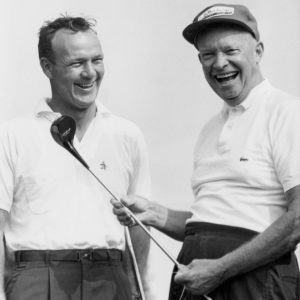From medieval Scotland to the White House, the game has appealed to the powerful as well as the common man.
June 3, 2020
The history of golf is a tale of two sports: one played by the common man, the other by kings and presidents. The plebeian variety came first. Paganica, a game played with a bent stick and a hard ball stuffed with feathers, was invented by Roman soldiers as a way to relieve the monotony of camp life. It is believed that a version of Paganica was introduced to Scotland when the Roman emperor Septimius Severus invaded the country in 208 A.D.

Golf buddies Arnold Palmer (left) and Dwight Eisenhower.
PHOTO: AUGUSTA NATIONAL/GETTY IMAGES
Golf might also have been influenced by stick-and-ball games from other cultures, such as the medieval Chinese chuiwan (“hit-ball”) and Dutch colf, an indoor game using rubber balls and heavy clubs. But the game we know today originated in the 15th century on the Links—the long, grassy sand dunes that are such a distinctive feature of Scotland’s coastline. The terrain was perfect for all-weather play, as well as for keeping out of sight of the authorities: Scottish kings prohibited the game until 1502, anxious that it would interfere with archery practice.
Two years after lifting the ban, King James IV of Scotland played the first recorded golf match while staying at Falkland Palace near St. Andrews. In theory, anyone could play on the Links since it was common land. Starting in 1754, however, access was controlled by the Royal and Ancient Golf Club of St. Andrews, known today as the “Home of Golf.” The R & A did much to standardize the rules of the game, while cementing golf’s reputation as an aristocratic activity.
In the 19th century, innovations in lawn care and ball manufacturing lowered the cost of golf, but the perception of elitism persisted. When William Howard Taft ran for president in 1908, Teddy Roosevelt urged him to beware of projecting an upper-crust image: “photographs on horseback, yes; tennis, no. And golf is fatal.” Taft ignored Roosevelt’s advice, as did Woodrow Wilson, who played more rounds of golf—nearly 1,200 in all—than any other president. He even played in the snow, using a black-painted ball.
Wilson’s record was nearly matched by Dwight Eisenhower, who so loved the game that he had a putting green installed outside the Oval Office in 1954. At first the media criticized his fondness for a rich man’s game. But that changed after Arnold Palmer, one of the greatest and most charismatic golfers in history, became Eisenhower’s friend and regular golf partner. The frequent sight of the president and the sports hero playing together made golf appear attractive, aspirational and above all accessible, inspiring millions of ordinary Americans to try the game for the first time.
But that popularity has been dented in recent years. The number of golfers in the U.S. dropped from a high of 30 million in 2005 to 24.1 million in 2015. In addition to being pricey, golf is still criticized for being snobby. Earlier this year, Brooks Koepka, a professional golfer once ranked number one in the world, told GQ that he loved the game but not “the stuffy atmosphere that comes along with it.” “Golf has always had this persona of the triple-pleated khaki pants, the button-up shirt, very country club atmosphere,” he complained. Now that almost all of the country’s golf courses have reopened from pandemic-related shutdowns, golf has a new opportunity to make every player feel included.





